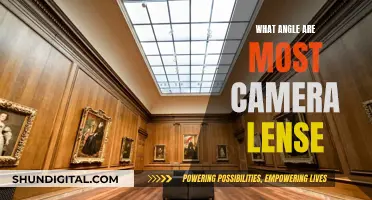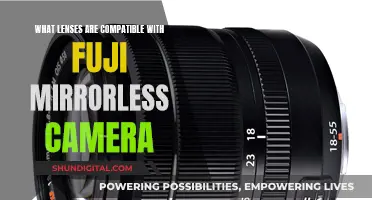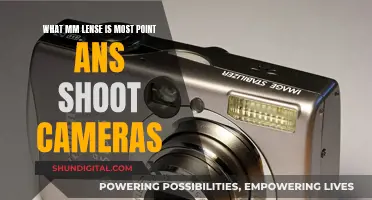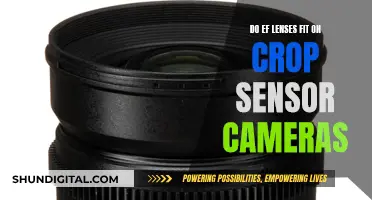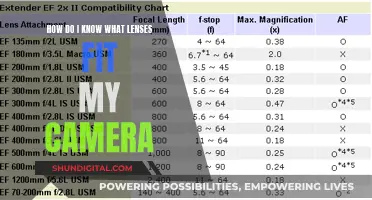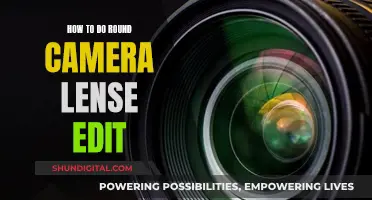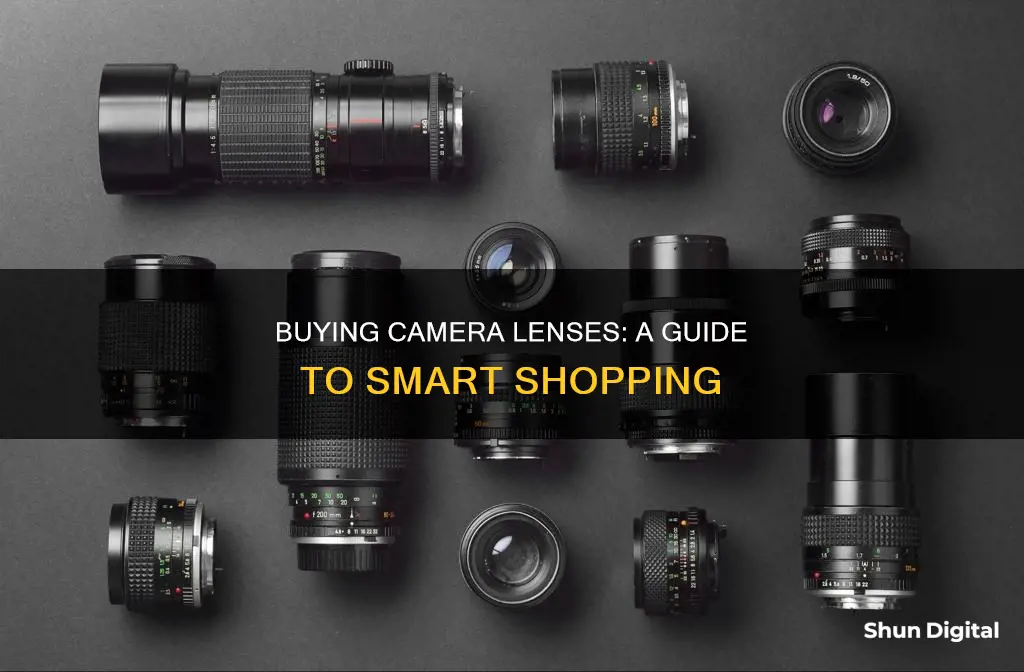
Purchasing a camera lens can be a daunting task, especially with the variety of options available. The first step is to determine your photography requirements. Different lenses cater to different needs, such as portrait, landscape, or wildlife photography. The most common types of lenses are prime and zoom lenses. Prime lenses have a fixed focal length and are ideal for low-light settings, while zoom lenses offer a range of focal lengths, making them versatile and suitable for travel. Another factor to consider is the focal length, which determines how wide or zoomed-in your shot will be. Additionally, the aperture, represented by the letter f and an f-stop number, controls how much light enters the lens, with smaller f-stop numbers allowing more light in. When buying a lens, it's also important to ensure compatibility with your camera's sensor and lens mount. Lastly, consider your budget and whether you want to invest in a name-brand or third-party lens.
| Characteristics | Values |
|---|---|
| Focal length | Defines how wide or zoomed-in a view the lens provides |
| Aperture | Expressed as 'F' or 'f/'; describes how much light the lens can gather and its ability to blur the image background |
| Image Stabilization | Some lenses include optical stabilization units to counteract the blurring effects of hand shake |
| Format | Describes the sensor size the lens is designed to work with |
| Lens mount | Determines whether the lens will physically fit your camera |
What You'll Learn
- Focal length: The distance from the lens to the sensor when the subject is in focus. The lower the number, the wider the shot
- Aperture: The measure of how much light can enter the camera, represented by the letter 'f' and corresponding numbers
- Prime vs. zoom lens: Prime lenses are good for brightness, zoom lenses are good for getting close to the subject
- Compatibility with your camera's sensor: Check your camera's sensor is compatible with the lens
- Budget: Different types of lenses have different price points

Focal length: The distance from the lens to the sensor when the subject is in focus. The lower the number, the wider the shot
Focal length is a fundamental parameter of a lens. It describes the distance between the rear principal point and the sensor, or in other words, the distance from the centre of the lens to the point where light rays converge to form a sharp image on the surface of a digital sensor or film. Focal length is usually given in millimetres (mm).
The focal length of a lens determines the angle of view, or how wide the image is. A shorter focal length gives a wider image, while a longer focal length allows you to zoom in for a narrow, closely cropped shot. The longer the focal length, the closer you can zoom in on a distant subject.
For example, an 18-55mm lens is a good choice as a general-use lens, and is often included as the kit lens with entry-level DSLR or mirrorless cameras. For more zoom power, you can opt for a telephoto lens, which typically falls within the 55-300mm range.
It's important to note that the same focal length lens will produce different results depending on the camera's sensor size. For instance, a 50mm focal length on a cropped-sensor camera will yield a narrower angle of view than on a full-frame camera. To get the equivalent field of view of a full-frame lens on a cropped-sensor camera, you would need to multiply the focal length by 1.6 for Canon lenses or 1.5 for Nikon lenses.
In addition to focal length, other key specifications to consider when purchasing a camera lens include aperture, image stabilisation, format, and lens mount.
Lens and Camera Compatibility: Universal Fit or Not?
You may want to see also

Aperture: The measure of how much light can enter the camera, represented by the letter 'f' and corresponding numbers
Aperture is one of the three pillars of photography, alongside shutter speed and ISO. It is the opening in a lens through which light passes to enter the camera. The aperture can be widened or shrunk to allow more or less light to reach the camera sensor.
The aperture is expressed in f-numbers like f/1.4, f/2, f/2.8 and so on, which indicate the size of the lens opening. A lower f-number denotes a greater aperture, which allows more light to reach the film or image sensor. A larger aperture (a wide opening) will pass a lot of light, resulting in a brighter photograph. Conversely, a small aperture does the opposite, making a photo darker.
Aperture also affects the depth of field, which is the amount of your photograph that appears sharp from front to back. A large aperture gives a blurred background with a beautiful shallow focus effect, which is popular for portrait photography. A small aperture will ensure that both the foreground and background are as sharp as possible, which is ideal for landscape photography.
The maximum aperture is usually the most important feature of a lens as it tells you how much light the lens can gather. A lens with a maximum aperture of f/1.4 or f/1.8 is considered a "fast" lens because it can pass through more light than a "slow" lens with a maximum aperture of f/4.0.
The minimum aperture is not as important because almost all modern lenses can provide at least f/16. You will rarely need anything smaller than that for day-to-day photography.
Adjusting Camera Lenses: The Ultimate Guide to Perfect Focus
You may want to see also

Prime vs. zoom lens: Prime lenses are good for brightness, zoom lenses are good for getting close to the subject
Prime lenses have a fixed focal length, whereas zoom lenses have a variable focal length, allowing you to adjust your focal length within a specified range. This gives zoom lenses an advantage as it eliminates the need to change lenses or move around to get the right shot.
Prime lenses are often favoured for their ability to produce sharper images. This is because they have fewer moving parts and optical elements, reducing the chances of abnormalities. Prime lenses also tend to be more compact and lightweight, and are generally cheaper to buy. They also have wider apertures, which is great for shooting in low-light conditions, and for creating a shallow depth of field.
Zoom lenses are bulkier and heavier than prime lenses, and are more prone to distortion and chromatic aberration. However, they are incredibly versatile and flexible, and are perfect for beginners as they allow you to experiment with different focal lengths without having to switch lenses. Zoom lenses are also great if you're travelling or working on the road and want to simplify your lens kit.
Cracking Camera Lenses: A Step-by-Step Guide to Mastery
You may want to see also

Compatibility with your camera's sensor: Check your camera's sensor is compatible with the lens
When purchasing a camera lens, it is important to ensure compatibility with your camera's sensor. The lens must be carefully chosen to match the design specifications of the image sensor so that it can accurately capture light and convert it into an electrical signal that is readable by processors. Without this balance, captured images may be distorted or inaccurate.
The first step is to determine the lens mount of your camera, which is the type of connection between the camera body and the lens. Once you know the lens mount, you can choose a lens that is compatible with that mount. Different camera manufacturers have their own mount types, and lenses are designed to fit specific mounts. For example, Canon cameras use the EF mount, while Nikon cameras use the F mount.
The next consideration is the sensor size of your camera. Different cameras have different sensor sizes, and lenses are designed to work with specific sensor sizes. A full-frame camera has a larger sensor than a crop-sensor camera, so a lens designed for a full-frame camera may not work well with a camera that has a smaller sensor. Conversely, a lens designed for a crop-sensor camera may not cover the entire sensor of a full-frame camera, resulting in a smaller image.
To ensure compatibility, it is important to check the specifications of both the lens and the camera sensor. The lens should be chosen based on the desired field of view and the sensor's size. The lens projects an image in a circular shape called the image circle, which should be large enough to cover the entire sensor.
Additionally, the back focal distance, or the distance from the lens's rear element to the image sensor, is crucial for ensuring compatibility with camera housings and mounts. The resolution of the image sensor should also match the resolving power of the lens to utilize its full potential.
By carefully considering these factors, you can ensure that your new camera lens is compatible with your camera's sensor and avoid issues such as reduced image quality, improper magnification, and field-of-view challenges.
Camera Lenses: Understanding Their Value and Depreciation Over Time
You may want to see also

Budget: Different types of lenses have different price points
When it comes to purchasing camera lenses, there is a wide range of options available, each with its own unique features and price points. The cost of a camera lens can vary significantly depending on factors such as the type of lens, its quality, and the brand. Here are some things to keep in mind when considering your budget for different types of camera lenses:
Standard Zoom or Wide-Angle Lenses:
Standard zoom or wide-angle lenses are versatile and suitable for various photography needs, from landscapes to portraits. The price range for these lenses can start as low as $100 and go up to $2,000 or more. For example, the Sigma 24-70mm F2.8 EX DG lens, which is compatible with various DSLR and 35mm SLRs, costs around $570.
Telephoto Lenses:
Telephoto lenses are ideal for capturing distant subjects, such as wildlife or sporting events. They typically offer a narrower field of view and are more expensive than standard zoom lenses. The price range for telephoto lenses starts at around $150 and can go up to $5,000 or more. For instance, the Canon EF 100-400mm f/4.5-5.6L IS USM lens, equipped with two image stabilizer modes, falls within this higher price range at approximately $1,500.
Prime Lenses:
Prime lenses offer a fixed focal length and are known for their high-quality optics and larger apertures, making them suitable for low-light conditions and portrait photography. The price range for prime lenses can vary from $100 to $5,000 or more. The AF-S Nikkor 50mm f/1.4G, a versatile lens for general-purpose photography, costs around $450.
Specialty Lenses:
Specialty lenses, such as macro and fish-eye lenses, serve specific purposes and can enhance your creativity. Macro lenses are ideal for extreme close-ups of small objects, while fish-eye lenses provide a distorted, bubble-like effect. The price range for specialty lenses starts at around $60 and can go up to $2,000 or more.
Beginner, Intermediate, and Advanced Lenses:
The cost of camera lenses also depends on the skill level of the photographer. Beginner lenses typically range from $100 to $400, while intermediate or advanced hobbyist lenses can cost between $200 and $700. Pro-level lenses, on the other hand, can start at $500 and go up to $11,000, offering the best image quality, widest maximum lens openings, and advanced features.
In summary, when budgeting for a camera lens, consider the type of lens, its features, brand, and your level of expertise. Remember that investing in a high-quality lens can significantly enhance your photography experience and the final images you capture.
Understanding Camera Lenses: Long Focal Points Explained
You may want to see also
Frequently asked questions
The basic types of lenses are standard zoom, wide-angle, telephoto, and prime. Standard zoom lenses are the most common bundled lenses and cover the angles of view most useful for day-to-day photography. Wide-angle lenses have smaller focal lengths, capturing broader angles of view. Telephoto lenses have long focal lengths and are useful for capturing distant subjects. Prime lenses have a fixed focal length and typically offer brighter optics, making them ideal for low-light photography.
Build quality is important, and higher-quality lenses often come with features like dust and splash protection, anti-smudge coatings, and lens hoods. Optical stabilization is another useful feature, especially for telephoto lenses, as it helps compensate for camera shake and results in sharper images. Additionally, consider lenses with control buttons, toggle switches, or control rings for added functionality.
Prime lenses have a fixed focal length and are generally smaller, lighter, and cheaper than zoom lenses. They offer brighter optics and are excellent for low-light photography, making them a popular choice for portraiture and studio work. Zoom lenses, on the other hand, offer a range of focal lengths, allowing you to capture both close-up and distant subjects without changing lenses. They are versatile and ideal for travel photography.
Each camera system has a specific lens mount, so compatibility is crucial. Check your camera's user manual or search online to identify the correct lens mount for your camera. Additionally, consider the sensor size; full-frame lenses will only fit full-frame cameras, while cropped-sensor cameras can accommodate both full-frame and APS-C lenses.


